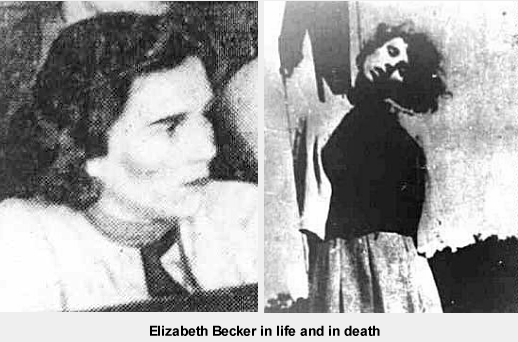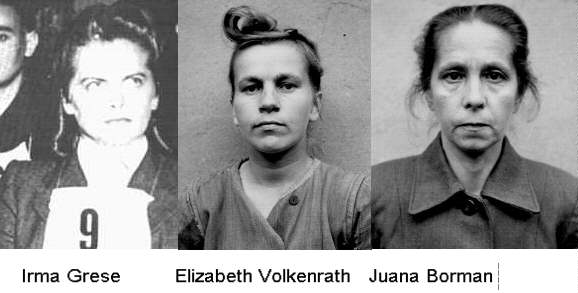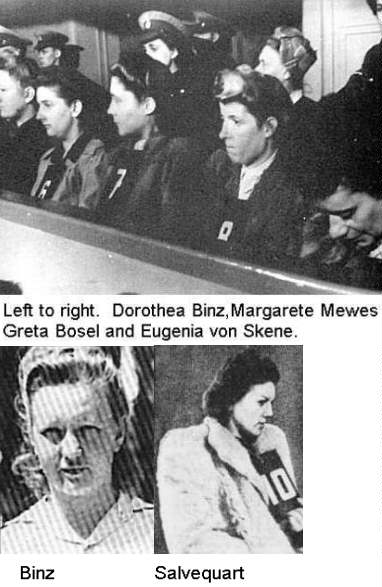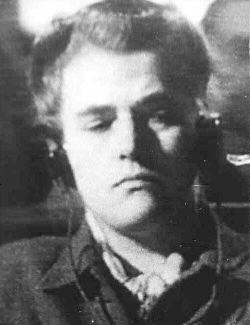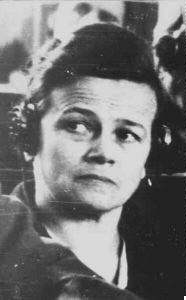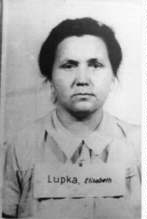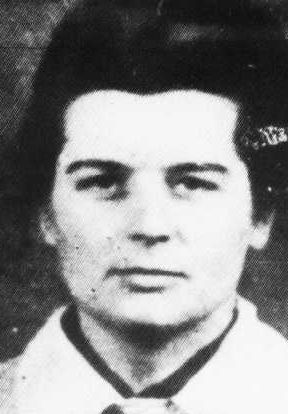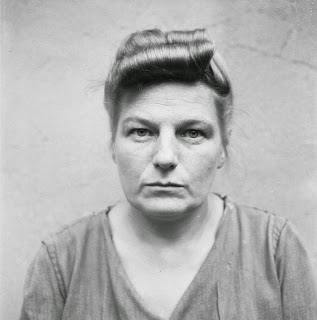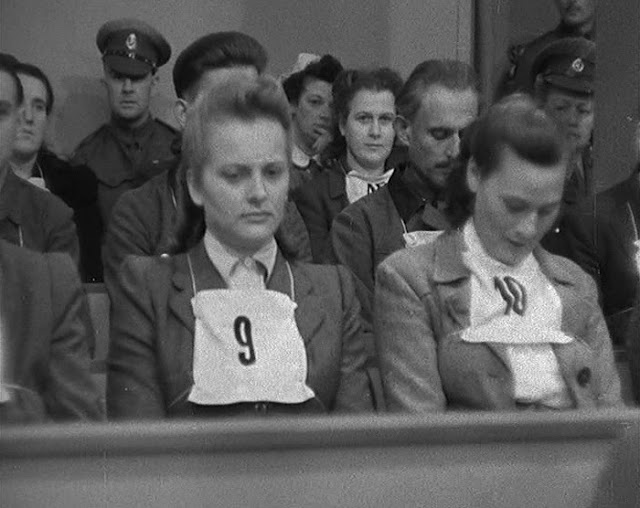STUTTHOF CONCENTRATION CAMP PART 10/10
APPENDIX:
HISTORICAL REVISIONISM-THE STUTTHOF GAS CHAMBER-
Structure and Method of Functioning: ABRIDGED- for further reading refer to:
http://vho.org/aaargh/fran/livres6/CMJGStutthof.pdf
Before examining the question of the mass gassing of human beings, the structure and functioning of the reported killing installation must first be examined.
There are no surviving documents relating to the Stutthof gas chamber, located approximately 10 meters north of the crematorium. According to the official historiography, it was built in 1943 for dis-infestation purposes.
The gas chamber (photo 1) is a small, rectangular structure 8.5 meters in length, 3.5 meters in width, and 2.55 meters in height (exterior measurements). The walls are of ordinary brick masonry; the ceiling is of reinforced concrete. The chamber had two gas-tight steel doors, located opposite each other. The steel doors were removed before the arrival of the Soviet troops, probably upon instructions from the camp authorities, as can be seen from a Soviet photograph taken in 1945 (photograph 2). The doors in existence today, of light sheet steel (photos 3 and 4), were installed after the liberation. To the left of the south door, on the exterior wall, is a small brick
oven (photos 5 and 6); the front side of the oven contains two small metal doors. The upper door is the fire door; the lower one is the ash door. The first was used to seal the coke-fired combustion chamber, containing
a grid of diagonal rods. An opening pierced in the rear wall links the combustion chamber to a cast iron pipe inside the gas chamber. The oven doors bear the inscription “Patent Bzrajber”.
The interior volume of the chamber is 8 m × 3 m × 2.50 m. The floor is of perforated brick; the holes are filled with cement. The walls are whitewashed; the ceiling is of rough cement. At oven height, the above mentioned cast iron pipe, approximately 25 cm in diameter, runs along the west wall; the pipe then bends at a right angle, rises perpendicularly up the north wall (photo 8) and leads out of the roof of the chamber into a brick chimney (photo 9). Today, this pipe is almost enclosed by a wall, forming a solid section 65-cm high and 50 cm wide. It is only uncovered in short sections visible in photo 7. As may be seen in a Soviet photograph taken after the liberation of the camp, the first half of the pipe was originally surrounded by a wall of perforated brick, of the type used in construction of the floor; the other half was uncovered. A circular opening 15-cm in diameter was pierced in the middle of the ceiling (photo 10). Above is a metal shaft with a lid (photo 11). Directly beneath the above-mentioned opening in the floor is a small drain (photo 12) formerly equipped with a protective grate.
Enormous migrating stains of iron cyanide (Prussian Blue) are visible on all four inside walls of the chamber, clearly proving the use of hydro-cyanic acid gas in this building (photo 13). Blue pigmentation has also formed around the circular opening in the ceiling. Finally, enormous blue stains are visible on the exterior walls of the chamber,particularly, on the east (photos 14 and 15) and west walls (photos (16 and 17), and, to a lesser extent, near the doors on the north and south walls as well (photos 5 and 9). This gas chamber may appear to have been rather crudely constructed in comparison with the Degesch circulation air installations for disinfestation with Zyklon B, but it was quite capable of functioning effectively. The relatively low temperature required for the rapid evaporation of hydrocyanic acid out of the granular carrier was ensured by the combustion products of the oven; the combustion products heated the cast iron pipe, as well as the walls of perforated brickwork partially surrounding the pipe, and then rose through the chimney into the open air. The small shaft in the ceiling made it possible to shake out the Zyklon B even with the door closed, after covering the opening of the drain in the floor with paper. Simultaneously opening the two doors along the north-south-west axis achieved rather rapid and efficient ventilation. This was accelerated by the heat which continued to radiate all along the pipe; if the fire was kept burning during ventilation as well, the result was an air flow inside the chamber which would have been sufficient to ensure an almost complete air exchange in a short time. Contrary to J.-C. Pressac’s impression, the opening in the ceiling was quite necessary to the functioning of the installation. Simply sprinkling Zyklon B granulate on the floor would have been prevented by the metal rack upon which the articles of clothing were to be hung and then dis-infested, occupying the entire surface area of the gas chamber right up to the doors. That this opening was in-stalled on the murderous instructions of Rudolf Höß, was simply invented by Pressac. Nevertheless, the use of these delousing chambers in their original condition for the killing of human beings would have been possible in a purely technical sense. The time periods mentioned in the Soviet Expert Commission, as well as the method of procedure described in the report, lie with the realm of the possible, at least theoretically. [Jean-Claude Pressac was a French chemist and pharmacist who later became a published authority on the Holocaust of World War II.Pressac was originally a Holocaust denier who, with Robert Faurisson, attempted to disprove what he considered historically inaccurate depictions of the concentration camps Auschwitz and Birkenau as extermination camps. Upon visiting Auschwitz in 1979, however, Pressac was able to view first-hand the extensive archive of construction documents which had survived due to being located in the construction office rather than the administrative offices. These convinced him that his former views were in error, an event he describes in the postface of Auschwitz: Technique and operation of the gas chambers, saying that he "nearly did away with myself one evening in October 1979 in the main camp, the Stammlager, overwhelmed by the evidence and by despair". He published his conclusions along with much of the underlying evidence in his 1989 book, Auschwitz: Technique and operation of the gas chambers. In his 1993 Les Crématoires d'Auschwitz, he further delineated the operation of the crematoria at Auschwitz, and their integration into the larger Nazi program to eradicate the Jews of Europe. Pressac estimates that between 631,000 and 711,000 were killed at Auschwitz.sic]
THE CREMATION
The following, therefore, is intended to raise the question from the historical point of view: First, of course, a few remarks on the camp crematorium are in order. The crematorium, of course, plays quite a second-rate role in connection with the reported extermination of human beings, but the data of eyewitnesses with relation to its function and capacity are a solid criterion for an evaluation of their general credibility. In Stutthof, two of the coke-fueled ovens were installed by the H. Kori concern (photo 18); the same firm also installed one oil-fired oven. These three ovens are exhibited in the crematorium reconstructed by the Poles after the war.
There are no surviving documents relating to the crematorium. All statements contained in the technical literature on this installation are based on eyewitness testimonies. The most detailed information is found in Ewa Ferenc, quote: “The plans of the camp crematorium were fulfilled with the plans of the new camp. The camp was to have had eight double ovens and one morgue, to be linked to the ovens by a lift. A gold workshop with a safe and 4 rooms measuring 20 m x 2 m in surface area were to be connected to the crematorium. On the plan, the rooms were designated with the letters z.b.V. (zur besonderen Verfügung) [for special duty]. The ovens
were to cremate approximately 100 corpses in one hour. According to the plans, the whole crematorium was to be surrounded by a high wall. The plan, however, was not put into effect.”
As a source, the Polish historian refers to the testimony of the former inmate Wacaw Lewandowski. The latter, however, provided a distorted description of the original crematorium project. A document from the Central Building Administration of Auschwitz offers a background explanation: on June 15, 1942, the Bauleitung of Stutthof concentration camp requested the Central Building Administration of Auschwitz for information on the installation of a crematorium. The head of the Central Building Administration, SS Hauptsturmführer Karl Bischoff, replied on July 10, enclosing the plans for the future Crematorium II of Birkenau, providing for the construction of “5 three muffle crematory ovens”. Bischoff also reported that, according to the oven manufacturer, Topf, the period of time required for the cremation of one corpse amounted to one half hour. This information was not however in accordance with reality, but was rather the reflection of wishful thinking. In actual fact, the average cremation time for a corpse amounted to one hour. The witness Lewandowski therefore, not only got the number of ovens wrong, but mentioned the wrong model as well (“eight double ovens” instead of five three muffle ovens); he also exaggerated the crematory capacity by three-fold (six corpses instead of two), in
comparison to the capacity reported by Topf. E. Ferenc continues: “In the summer of 1942, an oil-fueled crematory oven was delivered. It was installed on the east side of the infirmary, with a wooden roof built over it; the terrain of the crematorium was set apart from the camp. The oven was in operation approximately one half year. It burnt 5-6 corpses in 45 minutes, using approximately 5 litres of oil to do so. The first cremation took place on September 1, 1942 […] At the end of 1942, the Kori Corporation in Berlin built two walled crematory ovens and one chimney 18 meters long. An oven burnt 7-8 corpses in 45 minutes. Over the oven, a barrack of wood was constructed; this burnt down in the night of December 3-4. For this reason, the wooden barrack was replaced by a stone barrack, with a room for the heater, toilets, and two small rooms ‘z.b.V.’ [for special duty] After
reconstruction, the crematorium began to ‘work’ again on December 26, 1944. Until then, the corpses of inmates were burnt in a field crematorium.
This information, again exclusively based on eyewitness reports, is on a weak footing as well, both historically and technically. As regards the historical aspects, the only known original plan of the camp, which dates back to January 25, 1943, contains no designation of a crematorium—which means that it was not even begun at the time. The story of the burnt barrack therefore presumably relates to the oil-fueled oven. That this was put out of operation after only six months of use—even before the stationary ovens were built—is highly improbable. That not one single oven was in operation for fully three years—until December 26, 1944—is refuted by several
documents, first of all the death registry, the section of which relating to the time period between January and April 1944 has survived, and which contains an indication of cremation dates. Technically speaking, it is impossible to burn five to six corpses in 45 minutes in an oil-fueled Kori oven. The book on Majdanek discusses a German report attributing a capacity of 50 corpses in 12 hours to this type of oven. The hypothesis at that time—that such a high capacity was actually within the realm possibility under ordinary circumstances—is refuted by the documentation relating to the oil-fueled ovens of the crematorium at Theresienstadt, which was still unknown at that time. These ovens were very much bigger than the Kori ovens, but could only cremate two corpses per hour. The capacity of the oil-fueled Kori Ovens could under no circumstances have been higher.
The claim that seven to eight corpses could be cremated in one oil-fueled Kori oven in 45 minutes is quite absurd; the documentation on the coke-fueled Kori ovens at the Dutch Westerbork transit camp proves that a cremation took an average of 50 minutes. All this shows that the official Polish historiography, as well as the Soviet expert report quoted in the second chapter relating to the capacity of the crematory ovens at Stutthof, is devoid of all scientific basis. In particular, the statement contained in the Soviet report that 12 corpses could normally be introduced into one combustion chamber, and that they could be cremated in only 50 minutes, is pure nonsense:– first, the calculations of the Soviet “experts” are based upon the theoretical volume of the combustion chamber and corpses, as if the first were a container and the second a liquid, a certain quantity of which could simply be poured into the container;– second, cramming the combustion chamber with 12 corpses—which would be infeasible in any case—would have interrupted the combustion process in the coke ovens due to lack of draft. Even in the oil-fueled ovens, combustion would have been impossible, because the flame would have been extinguished by the corpses stacked up near the combustion nozzle.– third, even if combustion was possible—and it was not—it would have taken ten to twelve times as long as the time indicated. Precisely this was true, in particular, of the animal corpse combustion installations built by the Kori Corporation—the only existing oven comparable to the ovens reported for Stutthof.
[The combustion of the coke in the gas generator of a coke oven is directly dependent upon the suction draft of the chimney, which must be sufficiently large to overcome the resistance of the layer of coke against the passage of combustion air through the layer of coke. Cramming the combustion chamber with 12 corpses would have blocked the connection opening between the gas generator and the combustion chamber as well as the combustion gas outlet, which was located behind the introduction door on the vault of the combustion chamber. For this reason, the cremation process would have immediately come to a full stop.
Source: HOLOCAUST Handbooks Series, Vol. 4: Further reading will be necessary to complete this narrative.
CONCLUSION
The official history of events at Stutthof concentration camp is a crass demonstration of the fact that the victors’ official version of history has reached a dead end. In 1947, the Communist “Commission for the Investigation of the German Crimes in Poland” alleged that Stutthof had been used as a ‘makeshift’ extermination camp. The number of victims was summarily established at 65,000, and it was alleged that many inmates had been murdered in the Stutthof delousing chamber. This official version of the camp history was not even revised after the end of Communist domination in Poland; this is in contrast to Auschwitz and Majdanek, where the number of victims—although incomparably more grossly exaggerated than was the case at Stutthof— was at least massively reduced. Western historians have never made any attempt to obtain knowledge about Stutthof through their own efforts; insofar as they have expressed any views on the subject at hall, they have been content to parrot the official Polish version. Today, more than half a century after the end of WWII, it is high time to approach the topic in a correct manner, and revise the distorted propaganda image of the camp. To do so does in no way trivialize the actual sufferings of Stutthof inmates; our research in no way denigrates the memory of the 26,000 human beings who actually died in the camp, or of the victims of the evacuation. Quite the contrary. The official historiography of National Socialist concentration camps contains endless discussion of imaginary victims, but very little discussion of the real victims of these camps; yet only the latter are worthy of our sympathy.
Source:
Jürgen Graf and Carlo Mattogno, in: 'Concentration Camp Stutthof and its Function in National Socialist Jewish Policy.
NOTE: ALL PICTURES WHICH I COPIED ARE FROM: http://vho.org/aaargh/fran/livres6/CMJGStutthof.pdf -
AND MIGHT GIVE BETTER DEFINITION AND A CLEARER IMAGE
APPENDIX:
HISTORICAL REVISIONISM-THE STUTTHOF GAS CHAMBER-
Structure and Method of Functioning: ABRIDGED- for further reading refer to:
http://vho.org/aaargh/fran/livres6/CMJGStutthof.pdf
Before examining the question of the mass gassing of human beings, the structure and functioning of the reported killing installation must first be examined.
There are no surviving documents relating to the Stutthof gas chamber, located approximately 10 meters north of the crematorium. According to the official historiography, it was built in 1943 for dis-infestation purposes.
The gas chamber (photo 1) is a small, rectangular structure 8.5 meters in length, 3.5 meters in width, and 2.55 meters in height (exterior measurements). The walls are of ordinary brick masonry; the ceiling is of reinforced concrete. The chamber had two gas-tight steel doors, located opposite each other. The steel doors were removed before the arrival of the Soviet troops, probably upon instructions from the camp authorities, as can be seen from a Soviet photograph taken in 1945 (photograph 2). The doors in existence today, of light sheet steel (photos 3 and 4), were installed after the liberation. To the left of the south door, on the exterior wall, is a small brick
oven (photos 5 and 6); the front side of the oven contains two small metal doors. The upper door is the fire door; the lower one is the ash door. The first was used to seal the coke-fired combustion chamber, containing
a grid of diagonal rods. An opening pierced in the rear wall links the combustion chamber to a cast iron pipe inside the gas chamber. The oven doors bear the inscription “Patent Bzrajber”.
The interior volume of the chamber is 8 m × 3 m × 2.50 m. The floor is of perforated brick; the holes are filled with cement. The walls are whitewashed; the ceiling is of rough cement. At oven height, the above mentioned cast iron pipe, approximately 25 cm in diameter, runs along the west wall; the pipe then bends at a right angle, rises perpendicularly up the north wall (photo 8) and leads out of the roof of the chamber into a brick chimney (photo 9). Today, this pipe is almost enclosed by a wall, forming a solid section 65-cm high and 50 cm wide. It is only uncovered in short sections visible in photo 7. As may be seen in a Soviet photograph taken after the liberation of the camp, the first half of the pipe was originally surrounded by a wall of perforated brick, of the type used in construction of the floor; the other half was uncovered. A circular opening 15-cm in diameter was pierced in the middle of the ceiling (photo 10). Above is a metal shaft with a lid (photo 11). Directly beneath the above-mentioned opening in the floor is a small drain (photo 12) formerly equipped with a protective grate.
Enormous migrating stains of iron cyanide (Prussian Blue) are visible on all four inside walls of the chamber, clearly proving the use of hydro-cyanic acid gas in this building (photo 13). Blue pigmentation has also formed around the circular opening in the ceiling. Finally, enormous blue stains are visible on the exterior walls of the chamber,particularly, on the east (photos 14 and 15) and west walls (photos (16 and 17), and, to a lesser extent, near the doors on the north and south walls as well (photos 5 and 9). This gas chamber may appear to have been rather crudely constructed in comparison with the Degesch circulation air installations for disinfestation with Zyklon B, but it was quite capable of functioning effectively. The relatively low temperature required for the rapid evaporation of hydrocyanic acid out of the granular carrier was ensured by the combustion products of the oven; the combustion products heated the cast iron pipe, as well as the walls of perforated brickwork partially surrounding the pipe, and then rose through the chimney into the open air. The small shaft in the ceiling made it possible to shake out the Zyklon B even with the door closed, after covering the opening of the drain in the floor with paper. Simultaneously opening the two doors along the north-south-west axis achieved rather rapid and efficient ventilation. This was accelerated by the heat which continued to radiate all along the pipe; if the fire was kept burning during ventilation as well, the result was an air flow inside the chamber which would have been sufficient to ensure an almost complete air exchange in a short time. Contrary to J.-C. Pressac’s impression, the opening in the ceiling was quite necessary to the functioning of the installation. Simply sprinkling Zyklon B granulate on the floor would have been prevented by the metal rack upon which the articles of clothing were to be hung and then dis-infested, occupying the entire surface area of the gas chamber right up to the doors. That this opening was in-stalled on the murderous instructions of Rudolf Höß, was simply invented by Pressac. Nevertheless, the use of these delousing chambers in their original condition for the killing of human beings would have been possible in a purely technical sense. The time periods mentioned in the Soviet Expert Commission, as well as the method of procedure described in the report, lie with the realm of the possible, at least theoretically. [Jean-Claude Pressac was a French chemist and pharmacist who later became a published authority on the Holocaust of World War II.Pressac was originally a Holocaust denier who, with Robert Faurisson, attempted to disprove what he considered historically inaccurate depictions of the concentration camps Auschwitz and Birkenau as extermination camps. Upon visiting Auschwitz in 1979, however, Pressac was able to view first-hand the extensive archive of construction documents which had survived due to being located in the construction office rather than the administrative offices. These convinced him that his former views were in error, an event he describes in the postface of Auschwitz: Technique and operation of the gas chambers, saying that he "nearly did away with myself one evening in October 1979 in the main camp, the Stammlager, overwhelmed by the evidence and by despair". He published his conclusions along with much of the underlying evidence in his 1989 book, Auschwitz: Technique and operation of the gas chambers. In his 1993 Les Crématoires d'Auschwitz, he further delineated the operation of the crematoria at Auschwitz, and their integration into the larger Nazi program to eradicate the Jews of Europe. Pressac estimates that between 631,000 and 711,000 were killed at Auschwitz.sic]
 |
| (1) Delousing chamber at Stutthof, in its present condition (1997). To the right: one of the two railway carriages standing on the narrow-gauge railway. |
 |
| (2)Delousing chamber at Stutthof, viewed from the south-west. Soviet photo taken in 1945. The rectangular frames of the gas-tight door is visible on the south side. |
 |
| (3)Delousing chamber at Stutthof, viewed from the south. The door today is of lightweight sheet metal, to protect the museum-like interior. |
 |
| (4)Delousing chamber in Stutthof, viewed from the south. The door today. It is not alleged that this door is the original. |
 |
| (5)Delousing chamber at Stutthof, viewed from the south. The oven was used to heat the air inside of the delousing chamber. |
 |
| (6)Delousing chamber at Stutthof, viewed from the south. The oven was used to heat the air inside the delousong chamber. Above the fire door, Below: The ash door |
 |
(11)Delousing chamber at Stutthof, roof. Metallic pipe with lid, leading to the introduction hatch. Soviet photograph taken in 1945. Next to the pipe stands a can of Zyklon B.
|
 |
| (12)Delousing chamber at Stutthof, interior. Drainage shaft in the middle of brick floor underneath the Zyklon B introduction hatch. |
 |
| (13)Delousing chamber at Stutthof, interior view from the south door. All the walls exhibit the typical blue pigmentation caused by iron cyanide |
 |
| (14)Delousing chamber at Stutthof, viewed from the east. The wall exhibits two large bluely stained areas unequivocally indicating the use of Zyklon B. |
 |
| (15)Delousing chamber at Stutthof, east side, exterior. The brick exhibits the typical blue pigmentation caused by iron cyanide |
 |
(16)Delousing chamber at Stutthof, east side. Right: the second of two narrow-gauge railway carriages is visible behind the cross. To the right: the crematorium, rebuilt after the war
|
 |
(17)Delousing chamber at Stutthof, east side. Blue stains on the wall prove the use of Zyklon B.
|
 |
| (18)The two coke-fuelled crematory ovens built by H. Kori, viewed after the liberation of the camp (1945). |
The following, therefore, is intended to raise the question from the historical point of view: First, of course, a few remarks on the camp crematorium are in order. The crematorium, of course, plays quite a second-rate role in connection with the reported extermination of human beings, but the data of eyewitnesses with relation to its function and capacity are a solid criterion for an evaluation of their general credibility. In Stutthof, two of the coke-fueled ovens were installed by the H. Kori concern (photo 18); the same firm also installed one oil-fired oven. These three ovens are exhibited in the crematorium reconstructed by the Poles after the war.
There are no surviving documents relating to the crematorium. All statements contained in the technical literature on this installation are based on eyewitness testimonies. The most detailed information is found in Ewa Ferenc, quote: “The plans of the camp crematorium were fulfilled with the plans of the new camp. The camp was to have had eight double ovens and one morgue, to be linked to the ovens by a lift. A gold workshop with a safe and 4 rooms measuring 20 m x 2 m in surface area were to be connected to the crematorium. On the plan, the rooms were designated with the letters z.b.V. (zur besonderen Verfügung) [for special duty]. The ovens
were to cremate approximately 100 corpses in one hour. According to the plans, the whole crematorium was to be surrounded by a high wall. The plan, however, was not put into effect.”
As a source, the Polish historian refers to the testimony of the former inmate Wacaw Lewandowski. The latter, however, provided a distorted description of the original crematorium project. A document from the Central Building Administration of Auschwitz offers a background explanation: on June 15, 1942, the Bauleitung of Stutthof concentration camp requested the Central Building Administration of Auschwitz for information on the installation of a crematorium. The head of the Central Building Administration, SS Hauptsturmführer Karl Bischoff, replied on July 10, enclosing the plans for the future Crematorium II of Birkenau, providing for the construction of “5 three muffle crematory ovens”. Bischoff also reported that, according to the oven manufacturer, Topf, the period of time required for the cremation of one corpse amounted to one half hour. This information was not however in accordance with reality, but was rather the reflection of wishful thinking. In actual fact, the average cremation time for a corpse amounted to one hour. The witness Lewandowski therefore, not only got the number of ovens wrong, but mentioned the wrong model as well (“eight double ovens” instead of five three muffle ovens); he also exaggerated the crematory capacity by three-fold (six corpses instead of two), in
comparison to the capacity reported by Topf. E. Ferenc continues: “In the summer of 1942, an oil-fueled crematory oven was delivered. It was installed on the east side of the infirmary, with a wooden roof built over it; the terrain of the crematorium was set apart from the camp. The oven was in operation approximately one half year. It burnt 5-6 corpses in 45 minutes, using approximately 5 litres of oil to do so. The first cremation took place on September 1, 1942 […] At the end of 1942, the Kori Corporation in Berlin built two walled crematory ovens and one chimney 18 meters long. An oven burnt 7-8 corpses in 45 minutes. Over the oven, a barrack of wood was constructed; this burnt down in the night of December 3-4. For this reason, the wooden barrack was replaced by a stone barrack, with a room for the heater, toilets, and two small rooms ‘z.b.V.’ [for special duty] After
reconstruction, the crematorium began to ‘work’ again on December 26, 1944. Until then, the corpses of inmates were burnt in a field crematorium.
This information, again exclusively based on eyewitness reports, is on a weak footing as well, both historically and technically. As regards the historical aspects, the only known original plan of the camp, which dates back to January 25, 1943, contains no designation of a crematorium—which means that it was not even begun at the time. The story of the burnt barrack therefore presumably relates to the oil-fueled oven. That this was put out of operation after only six months of use—even before the stationary ovens were built—is highly improbable. That not one single oven was in operation for fully three years—until December 26, 1944—is refuted by several
documents, first of all the death registry, the section of which relating to the time period between January and April 1944 has survived, and which contains an indication of cremation dates. Technically speaking, it is impossible to burn five to six corpses in 45 minutes in an oil-fueled Kori oven. The book on Majdanek discusses a German report attributing a capacity of 50 corpses in 12 hours to this type of oven. The hypothesis at that time—that such a high capacity was actually within the realm possibility under ordinary circumstances—is refuted by the documentation relating to the oil-fueled ovens of the crematorium at Theresienstadt, which was still unknown at that time. These ovens were very much bigger than the Kori ovens, but could only cremate two corpses per hour. The capacity of the oil-fueled Kori Ovens could under no circumstances have been higher.
The claim that seven to eight corpses could be cremated in one oil-fueled Kori oven in 45 minutes is quite absurd; the documentation on the coke-fueled Kori ovens at the Dutch Westerbork transit camp proves that a cremation took an average of 50 minutes. All this shows that the official Polish historiography, as well as the Soviet expert report quoted in the second chapter relating to the capacity of the crematory ovens at Stutthof, is devoid of all scientific basis. In particular, the statement contained in the Soviet report that 12 corpses could normally be introduced into one combustion chamber, and that they could be cremated in only 50 minutes, is pure nonsense:– first, the calculations of the Soviet “experts” are based upon the theoretical volume of the combustion chamber and corpses, as if the first were a container and the second a liquid, a certain quantity of which could simply be poured into the container;– second, cramming the combustion chamber with 12 corpses—which would be infeasible in any case—would have interrupted the combustion process in the coke ovens due to lack of draft. Even in the oil-fueled ovens, combustion would have been impossible, because the flame would have been extinguished by the corpses stacked up near the combustion nozzle.– third, even if combustion was possible—and it was not—it would have taken ten to twelve times as long as the time indicated. Precisely this was true, in particular, of the animal corpse combustion installations built by the Kori Corporation—the only existing oven comparable to the ovens reported for Stutthof.
[The combustion of the coke in the gas generator of a coke oven is directly dependent upon the suction draft of the chimney, which must be sufficiently large to overcome the resistance of the layer of coke against the passage of combustion air through the layer of coke. Cramming the combustion chamber with 12 corpses would have blocked the connection opening between the gas generator and the combustion chamber as well as the combustion gas outlet, which was located behind the introduction door on the vault of the combustion chamber. For this reason, the cremation process would have immediately come to a full stop.
Source: HOLOCAUST Handbooks Series, Vol. 4: Further reading will be necessary to complete this narrative.
CONCLUSION
The official history of events at Stutthof concentration camp is a crass demonstration of the fact that the victors’ official version of history has reached a dead end. In 1947, the Communist “Commission for the Investigation of the German Crimes in Poland” alleged that Stutthof had been used as a ‘makeshift’ extermination camp. The number of victims was summarily established at 65,000, and it was alleged that many inmates had been murdered in the Stutthof delousing chamber. This official version of the camp history was not even revised after the end of Communist domination in Poland; this is in contrast to Auschwitz and Majdanek, where the number of victims—although incomparably more grossly exaggerated than was the case at Stutthof— was at least massively reduced. Western historians have never made any attempt to obtain knowledge about Stutthof through their own efforts; insofar as they have expressed any views on the subject at hall, they have been content to parrot the official Polish version. Today, more than half a century after the end of WWII, it is high time to approach the topic in a correct manner, and revise the distorted propaganda image of the camp. To do so does in no way trivialize the actual sufferings of Stutthof inmates; our research in no way denigrates the memory of the 26,000 human beings who actually died in the camp, or of the victims of the evacuation. Quite the contrary. The official historiography of National Socialist concentration camps contains endless discussion of imaginary victims, but very little discussion of the real victims of these camps; yet only the latter are worthy of our sympathy.
Source:
Jürgen Graf and Carlo Mattogno, in: 'Concentration Camp Stutthof and its Function in National Socialist Jewish Policy.



























